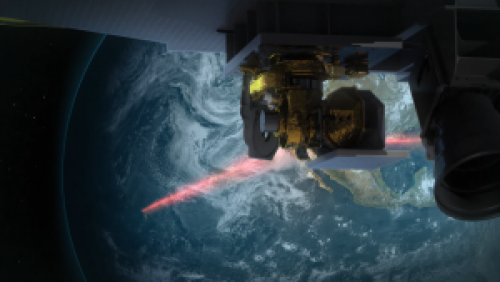New Ground Station Brings Laser Communications Closer To Reality
Optical communications, transmitting data using infrared lasers, has the potential to help NASA return more data to Earth than ever. The benefits of this technology to exploration and Earth science missions are huge. In support of a mission to demonstrate this technology, NASA recently completed installing its newest optical ground station in Haleakala, Hawaii.

Illustration of the LCRD payload transmitting an optical signal to OGS-2 in Haleakala, Hawaii.
The state-of-the-art ground station, called Optical Ground Station 2 (OGS-2), is the second of two optical ground stations to be built that will collect data transmitted to Earth by NASA’s Laser Communications Relay Demonstration (LCRD). Launching in early 2021, this trailblazing mission will be the linchpin in NASA’s first operational optical communications relay system. While other NASA efforts have used optical communications, this will be NASA’s first relay system using optical entirely, giving NASA the opportunity to test this method of communications and learn valuable lessons from its implementation. Relay satellites create critical communications links between science and exploration missions and Earth, enabling these missions to transmit important data to scientists and mission managers back home.

OGS-2 optical telescope dome.
While optical communications provides missions with many advantages, it can be disrupted by atmospheric interference such as clouds. OGS-2 was chosen to be located in Hawaii because of its clear skies, but bad weather can still happen. On a cloudy day, LCRD would have to wait before transmitting data. In order to avoid delays, services may be transferred to another ground station developed by NASA’s Jet Propulsion Laboratory; OGS-1, located in Table Mountain, California. To monitor cloud coverage and determine if OGS-1 is needed, commercial partner Northrop Grumman provided an atmospheric monitoring station that observes weather conditions at the site. This monitoring station runs nearly autonomously 24 hours a day, seven days a week.
LCRD and OGS-2 will demonstrate the numerous capabilities of optical, or laser, communications for use as a communications relay. Optical communications provides significant benefits for missions, including data rate increases of 10 to 100 times more than comparable radio frequency communications systems. This increase means higher resolution data for missions, giving scientists a much more detailed look at our planet and solar system. Benefits also include decreased power needs, size and weight, meaning longer battery life, more room for additional instruments on spacecraft and potential cost savings at launch due to lighter payloads.
“LCRD and its ground stations will demonstrate optical communications as a relay, which means missions will be able to transmit data from points in their orbit without direct line of sight of the ground stations,” said Dave Israel, LCRD principal investigator at NASA’s Goddard Space Flight Center in Greenbelt, Maryland. “In 2013, NASA’s Lunar Laser Communication Demonstration set a space communications bandwidth record from the Moon using optical communications with a system requiring direct line of sight.”
NASA’s Space Network manages OGS-2’s integration, test and operations and will eventually operate LCRD. The Space Network oversees a constellation of NASA communications satellites, known as Tracking and Data Relay Satellites, and their associated ground stations, which includes the White Sands Complex in White Sands, New Mexico. The network provides continuous communications services to missions in low-Earth orbit through radio frequency. While radio frequency will continue to have utility in space communications well into the future, the growing communications needs of many missions necessitates greater data rates.
OGS-2’s installation was a collaborative effort between government, commercial and academic institutions. The Massachusetts Institute of Technology’s Lincoln Laboratory provided the test and diagnostics terminal, which consists of three parts: an optical subsystem, digital subsystem and controller electronics. The three components send, receive and process optical signals to and from LCRD.
Optical communications, through the development of LCRD and its two ground terminals, could have far-reaching impacts for future knowledge of Earth and our solar system. Spacecraft equipped with optical communications systems will effectively allow enhanced data, such as high-resolution video, to be brought back down to Earth faster, thanks to increased data rates. With this data, scientists will get a closer look at our universe with the potential to uncover exciting new discoveries.
Source: U.S. National Aeronautics and Space Administration
- 458 reads
Human Rights
Fostering a More Humane World: The 28th Eurasian Economic Summi

Conscience, Hope, and Action: Keys to Global Peace and Sustainability

Ringing FOWPAL’s Peace Bell for the World:Nobel Peace Prize Laureates’ Visions and Actions

Protecting the World’s Cultural Diversity for a Sustainable Future

Puppet Show I International Friendship Day 2020

